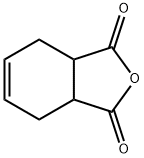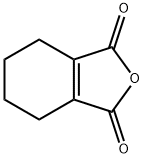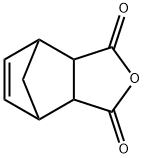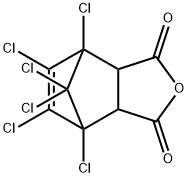1,2,3,6-Tetrahydrophthalic anhydride
- CAS NO.:85-43-8
- Empirical Formula: C8H8O3
- Molecular Weight: 152.15
- MDL number: MFCD00065335
- EINECS: 201-605-4
- SAFETY DATA SHEET (SDS)
- Update Date: 2024-12-18 13:37:16

What is 1,2,3,6-Tetrahydrophthalic anhydride?
Chemical properties
white flaky solid
The Uses of 1,2,3,6-Tetrahydrophthalic anhydride
Chemical intermediate for light-colored alkyds, polyesters, plasticizers, and adhesives; intermediate for pesticides; hardener for resins.
Definition
ChEBI: 1,2,3,6-tetrahydrophthalic anhydride is a cyclic dicarboxylic anhydride that is 1,3,3a,4,7,7a-hexahydro-2-benzofuran carrying oxo groups at positions 1 and 3. It is a cyclic dicarboxylic anhydride and a tetrahydrofurandione.
General Description
Clear colorless to light yellow slight viscous liquid. Highly toxic and a strong irritant to skin, eyes and mucous membranes. Corrosive to skin and metal. Used in making polyester, alkyd resins, and plasticizers.
Air & Water Reactions
Reacts exothermically with water to form memtetrahydrophthalic acid.
Reactivity Profile
CIS-1,2,3,6-TETRAHYDROPHTHALIC ANHYDRIDE; >98% is combustible. Reacts with oxidizers. Reacts exothermically with water. These reactions are usually slow, but can become violent when local heating accelerates their rate. Acids accelerate the reaction with water. Incompatible with acids, strong oxidizing agents, alcohols, amines, and bases.
Hazard
Strong irritant to eyes and skin.
Health Hazard
TOXIC; inhalation, ingestion or skin contact with material may cause severe injury or death. Contact with molten substance may cause severe burns to skin and eyes. Avoid any skin contact. Effects of contact or inhalation may be delayed. Fire may produce irritating, corrosive and/or toxic gases. Runoff from fire control or dilution water may be corrosive and/or toxic and cause pollution.
Fire Hazard
Non-combustible, substance itself does not burn but may decompose upon heating to produce corrosive and/or toxic fumes. Some are oxidizers and may ignite combustibles (wood, paper, oil, clothing, etc.). Contact with metals may evolve flammable hydrogen gas. Containers may explode when heated.
Flammability and Explosibility
Non flammable
Safety Profile
Moderately toxic by intraperitoneal route. Mildly toxic by ingestion. A corrosive irritant to skin, eyes, and mucous membranes. Combustible when exposed to heat or flame. Will react with water or steam to produce heat; can react with oxidizing materials. To fight fre, use water, foam, CO2, dry chemical. When heated to decomposition it emits acrid smoke and irritating fumes. See also ANHYDRIDES.
Properties of 1,2,3,6-Tetrahydrophthalic anhydride
| Melting point: | 101-102°C |
| Boiling point: | 195°C 5mm |
| Density | 1,375 g/cm3 |
| vapor pressure | 0.021Pa at 20℃ |
| refractive index | 1.4810 (estimate) |
| Flash point: | 157°C |
| storage temp. | Store below +30°C. |
| solubility | soluble in DCM, Ethyl Acetate, Toluene |
| pka | 3.84[at 20 ℃] |
| form | Solid |
| color | Off-White to Light Tan |
| Water Solubility | 29.4g/L at 20℃ |
| CAS DataBase Reference | 85-43-8(CAS DataBase Reference) |
| EPA Substance Registry System | Tetrahydrophthalic anhydride (85-43-8) |
Safety information for 1,2,3,6-Tetrahydrophthalic anhydride
| Signal word | Warning |
| Pictogram(s) |
 Exclamation Mark Irritant GHS07 |
| GHS Hazard Statements |
H315:Skin corrosion/irritation H319:Serious eye damage/eye irritation |
| Precautionary Statement Codes |
P264:Wash hands thoroughly after handling. P264:Wash skin thouroughly after handling. P280:Wear protective gloves/protective clothing/eye protection/face protection. P362:Take off contaminated clothing and wash before reuse. P302+P352:IF ON SKIN: wash with plenty of soap and water. P305+P351+P338:IF IN EYES: Rinse cautiously with water for several minutes. Remove contact lenses, if present and easy to do. Continuerinsing. P332+P313:IF SKIN irritation occurs: Get medical advice/attention. P337+P313:IF eye irritation persists: Get medical advice/attention. |
Computed Descriptors for 1,2,3,6-Tetrahydrophthalic anhydride
New Products
Tert-butyl bis(2-chloroethyl)carbamate 4-Methylphenylacetic acid N-Boc-D-alaninol N-BOC-D/L-ALANINOL N-octanoyl benzotriazole 3-Morpholino-1-(4-nitrophenyl)-5,6-dihydropyridin- 2(1H)-one Furan-2,5-Dicarboxylic Acid DIETHYL AMINOMALONATE HYDROCHLORIDE 1,1’-CARBONYLDIIMIDAZOLE R-2-BENZYLOXY PROPIONIC ACID 1,1’-CARBONYLDI (1,2-4 TRIAZOLE) N-METHYL INDAZOLE-3-CARBOXYLIC ACID (2-Hydroxyphenyl)acetonitrile 4-Bromopyrazole 5-BROMO-2CYANO PYRIDINE 5,6-Dimethoxyindanone 5-broMo-2-chloro-N-cyclopentylpyriMidin-4-aMine 2-(Cyanocyclohexyl)acetic acid 4-methoxy-3,5-dinitropyridine 1-(4-(aminomethyl)benzyl)urea hydrochloride 2-aminopropyl benzoate hydrochloride diethyl 2-(2-((tertbutoxycarbonyl)amino) ethyl)malonate tert-butyl 4- (ureidomethyl)benzylcarbamate Ethyl-2-chloro((4-methoxyphenyl)hydrazono)acetateRelated products of tetrahydrofuran

![1,14-DIMETHYL-4,10-DIOXATETRACYCLO[5.5.2.0(2,6).0(8,12)]TETRADEC-13-ENE-3,5,9,11-TETRAONE](https://img.chemicalbook.in/CAS/GIF/32251-35-7.gif)

![4-[3,5-DI(TRIFLUOROMETHYL)PHENYL]-1,3,3A,4,7,7A-HEXAHYDROISOBENZOFURAN-1,3-DIONE](https://img.chemicalbook.in/StructureFile/ChemBookStructure2/GIF/CB8199474.gif)


![ENDO-BICYCLO[2.2.2]OCT-5-ENE-2,3-DICARBOXYLIC ANHYDRIDE](https://img.chemicalbook.in/CAS/GIF/24327-08-0.gif)

You may like
-
 1,2,3,6-Tetrahydrophthalic anhydride CAS 85-43-8View Details
1,2,3,6-Tetrahydrophthalic anhydride CAS 85-43-8View Details
85-43-8 -
 1975-50-4 98%View Details
1975-50-4 98%View Details
1975-50-4 -
 2-HYDROXY BENZYL ALCOHOL 98%View Details
2-HYDROXY BENZYL ALCOHOL 98%View Details
90-01-7 -
 2-Chloro-1,3-Bis(Dimethylamino)Trimethinium Hexafluorophosphate 221615-75-4 98%View Details
2-Chloro-1,3-Bis(Dimethylamino)Trimethinium Hexafluorophosphate 221615-75-4 98%View Details
221615-75-4 -
 61397-56-6 CIS BROMO BENZOATE 98%View Details
61397-56-6 CIS BROMO BENZOATE 98%View Details
61397-56-6 -
 14714-50-2 (2-Hydroxyphenyl)acetonitrile 98+View Details
14714-50-2 (2-Hydroxyphenyl)acetonitrile 98+View Details
14714-50-2 -
 118753-70-1 98+View Details
118753-70-1 98+View Details
118753-70-1 -
 733039-20-8 5-broMo-2-chloro-N-cyclopentylpyriMidin-4-aMine 98+View Details
733039-20-8 5-broMo-2-chloro-N-cyclopentylpyriMidin-4-aMine 98+View Details
733039-20-8